The US’s affinity for cars, especially big ones, and sprawling cities and suburbs where driving to work, school and shop is often the only option, gives its transition to electric vehicles major global significance.
The Take-Away: The largest reduction will come from changing the way we get around towns and cities – fewer cars, more walking, cycling and public transit made possible by denser cities – followed by downsizing vehicles and recycling batteries.
✓ It can be done: cities around the world have already begun to reduce car use in order to improve air pollution, road safety and quality of life. In Paris, car use declined nearly 30% from 2001 to 2015, while in London it fell by nearly 40%.
Revealed: how US transition to electric cars threatens environmental havoc
The US’s transition to electric vehicles could require three times as much lithium as is currently produced for the entire global market, causing needless water shortages, Indigenous land grabs, and ecosystem destruction inside and outside its borders, new research finds.
It warns that unless the US’s dependence on cars in towns and cities falls drastically, the transition to lithium battery-powered electric vehicles by 2050 will deepen global environmental and social inequalities linked to mining – and may even jeopardize the 1.5C global heating target.
But ambitious policies investing in mass transit, walkable towns and cities, and robust battery recycling in the US would slash the amount of extra lithium required in 2050 by more than 90%.
In fact, this first-of-its-kind modeling shows it is possible to have more transport options for Americans that are safer, healthier and less segregated, and less harmful mining while making rapid progress to zero emissions.
The research by the Climate and Community Project and University of California, Davis, shared exclusively with the Guardian, comes at a critical juncture with the rollout of historic funding for electric vehicles through Joe Biden’s Inflation Reduction and Infrastructure Investment and Jobs Acts.
Recognizing the harms of ‘white gold’
The global demand for lithium, also known as white gold, is predicted to rise over 40 times by 2040, driven predominantly by the shift to electric vehicles. Grassroots protests and lawsuits against lithium mining are on the rise from the US and Chile to Serbia and Tibet amid rising concern about the socio-environmental impacts and increasingly tense geopolitics around supply.
The US’s affinity for cars, especially big ones, and sprawling cities and suburbs where driving to work, school and shop is often the only option, gives its transition to electric vehicles major global significance.
No matter what path it chooses, the US will achieve zero emission transportation by 2050, according to the research. But the speed of the transition – as well as who benefits and who suffers from it – will depend on the number and size of electric vehicles (and batteries) Americans opt for going forward.
“Preserving the status quo might seem like the politically easier option, but it’s not the fastest way to get people out of cars or the fairest way to decarbonize,” said Thea Riofrancos, associate professor of political science at Providence College and lead author of the report.
“We can either electrify the status quo to reach zero emissions, or the energy transition can be used as an opportunity to rethink our cities and the transportation sector so that it’s more environmentally and socially just, both in the US and globally.”
“The report brings into light possibilities for a future without fossil fuels that minimizes mineral extraction and new harms to communities in lithium-rich areas,” said Pía Marchegiani, policy director at the Environment and Natural Resources Foundation in Argentina.
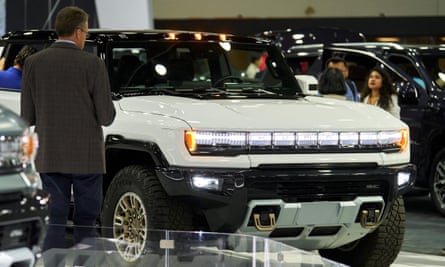
Transportation is the biggest source of carbon emissions in the US – and the only sector in which emissions are still rising – making it crucial to phase out gas and diesel vehicles as quickly as possible to limit the climate breakdown.
Biden’s strategy to fully decarbonize the transportation sector by 2050 puts some focus on mass transit and land-use planning, but so far the messaging – and funds – have been geared toward encouraging Americans to swap gas-guzzling cars for electric vehicles rather than change the way they travel.
It’s working: over half of the nation’s car sales are predicted to be electric by 2030, and states like New York and California have passed laws phasing out the sale of gas cars.
This is good news but there’s a catch: lithium.
Electric vehicles are already the largest source of demand for lithium – the soft, white metal common to all current rechargeable batteries.
Mining lithium is a fraught business, and the rise in demand for EVs is contributing to a rise in social and environmental harms – and global supply chain bottlenecks.
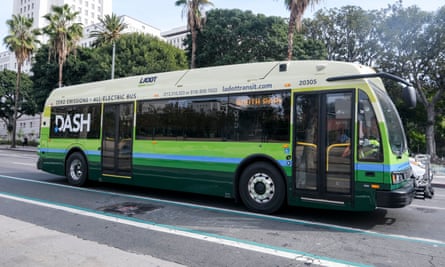
If Americans continue to depend on cars at the current rate, by 2050 the US alone would need triple the amount of lithium currently produced for the entire global market, which would have dire consequences for water and food supplies, biodiversity, and Indigenous rights.
But it doesn’t have to be this way, according to the report Achieving Zero Emission Transportation With More Mobility and Less Mining.
Best scenarios for battery size, city density and public transit
Researchers created a novel modeling tool to compare the amount of lithium needed to achieve zero transport emissions for personal vehicles (cars, trucks and SUVs) under different scenarios. It’s the first study to project future lithium demand based on variables like car ownership, battery size, city density, public transit and battery recycling, and connect this with avoidable harms.
In each scenario, the US achieves zero emission transportation by 2050 and in each case some additional lithium mining will be needed.
How much lithium depends on policy decisions taken now, according to the report, impacting economic prosperity, public health, environmental justice, ecosystems and communities at every part of the supply chain for decades to come.
In the best-case scenario – comparing the status quo in which EV battery size grows and US car dependency remains stable – with ambitious public transit, city density and recycling policies, the lithium demand would be 92% lower. (Battery size, like the size of a fuel tank, dictates range – or how far you can travel before having to recharge.)
But results show that even if Americans can’t wean themselves off cars with big lithium batteries, increasing the density of metropolitan areas and investing in mass transit would cut cumulative demand for lithium between 18% and 66%. Limiting the size of EV batteries alone can cut lithium demand by up to 42% by 2050.
The largest reduction will come from changing the way we get around towns and cities – fewer cars, more walking, cycling and public transit made possible by denser cities – followed by downsizing vehicles and recycling batteries.
It can be done: cities around the world have already begun to reduce car use in order to improve air pollution, road safety and quality of life. In Paris, car use declined nearly 30% from 2001 to 2015, while in London it fell by nearly 40%.
And despite the cultural attachment to driving, fewer cars on the roads would not mean a sacrifice in the quality of life, convenience or safety for Americans, according to coauthor Kira McDonald, an economist and urban policy researcher.
“If the policies, institutions, and spending patterns that shaped our existing car dependent infrastructure and built environment change, then alternative modes of transportation can be made far safer, far more convenient, and faster than cars – and immensely more pleasant and fun.”
Protecting people and the planet
Lithium deposits are geologically widespread and abundant, but 95% of global production is currently concentrated in Australia, Chile, China and Argentina. Large new deposits have been found in diverse countries including Mexico, the US, Portugal, Germany, Kazakhstan, Congo and Mali.
Lithium mining is, like all mining, environmentally and socially harmful. More than half the current lithium production, which is very water intensive, takes place in regions blighted by water shortages that are likely to get worse due to global heating.
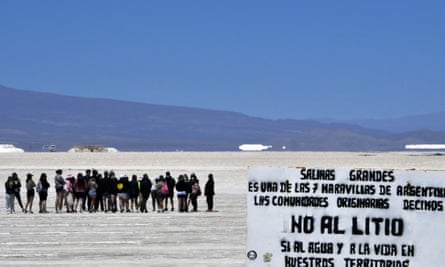
Despite being a relatively new industry, lithium extraction has a track record of land and water pollution, ecosystem destruction and violations against Indigenous and rural communities.
In the US, only one small lithium mine, in Nevada, is currently operational, but the drought-affected state has at least 50 new projects under development. This includes the massive Thacker Pass mine, approved at the end of the Trump administration, which is opposed by some environmentalists, ranchers and Indigenous tribes due to the lack of consultation and inadequate environmental review.
In Chile and Argentina, the world’s second- and fourth-largest lithium producers respectively, broken promises by corporations, water scarcity, land contamination and the lack of informed consent from Indigenous groups has fueled resistance and social conflicts.
The lithium rush is already gathering pace, but keeping lithium mining to an absolute minimum is crucial for frontline communities – and it also makes good economic sense, according to the report.
✓ forecasters predict a supply crunch in the next five to 10 years – a period when rapid decarbonization must take place to avert even more catastrophic global heating. The price of lithium batteries – the most expensive component of an EV – went up for the first time last year as demand outweighed supply.
Smaller batteries would make decarbonized transportation more affordable. In addition, expanding mass transit systems would improve pedestrian safety and air quality, generating health and economic benefits.
Payal Sampat, mining program director at Earthworks, said: “The findings of this report must jumpstart policies to invest in robust, accessible public transit systems that advance equity, reduce pollution and get people where they need to go.”
This story was updated on 24 January 2023 to correct the units in the graphic estimating how much lithium could be required to power US vehicles in 2050, earlier given in millions of tons.
RELATED CONTENT
The rush to ‘go electric’ comes with a hidden cost: Destructive lithium mining. As the world moves towards electric cars and renewable grids, demand for lithium is wreaking havoc in northern Chile.
news.mit.eduCan today’s EVs make a dent in climate change?
David L. Chandler | MIT News Office8 - 10 minutes
Could existing electric vehicles (EVs), despite their limited driving range, bring about a meaningful reduction in the greenhouse-gas emissions that are causing global climate change? Researchers at MIT have just completed the most comprehensive study yet to address this hotly debated question, and have reached a clear conclusion: Yes, they can.
The study, which found that a wholesale replacement of conventional vehicles with electric ones is possible today and could play a significant role in meeting climate change mitigation goals, was published today in the journal Nature Energy by Jessika Trancik, the Atlantic Richfield Career Development Associate Professor in Energy Studies at MIT’s Institute for Data, Systems, and Society (IDSS), along with graduate student Zachary Needell, postdoc James McNerney, and recent graduate Michael Chang SM ’15.
“Roughly 90 percent of the personal vehicles on the road daily could be replaced by a low-cost electric vehicle available on the market today, even if the cars can only charge overnight,” Trancik says, “which would more than meet near-term U.S. climate targets for personal vehicle travel.” Overall, when accounting for the emissions today from the power plants that provide the electricity, this would lead to an approximately 30 percent reduction in emissions from transportation. Deeper emissions cuts would be realized if power plants decarbonize over time.
The team spent four years on the project, which included developing a way of integrating two huge datasets: one highly detailed set of second-by-second driving behavior based on GPS data, and another broader, more comprehensive set of national data based on travel surveys. Together, the two datasets encompass millions of trips made by drivers all around the country.
The detailed GPS data was collected by state agencies in Texas, Georgia, and California, using special data loggers installed in cars to assess statewide driving patterns. The more comprehensive, but less detailed, nationwide data came from a national household transportation survey, which studied households across the country to learn about how and where people actually do their driving. The researchers needed to understand “the distances and timing of trips, the different driving behaviors, and the ambient weather conditions,” Needell says.
By working out formulas to integrate the different sets of information and thereby track one-second-resolution drive cycles, the MIT researchers were able to demonstrate that the daily energy requirements of some 90 percent of personal cars on the road in the U.S. could be met by today’s EVs, with their current ranges, at an overall cost to their owners — including both purchase and operating costs — that would be no greater than that of conventional internal-combustion vehicles. The team looked at once-daily charging, at home or at work, in order to study the adoption potential given today’s charging infrastructure.
What’s more, such a large-scale replacement would be sufficient to meet the nation’s stated near-term emissions-reduction targets for personal vehicles’ share of the transportation sector — a sector that accounts for about a third of the nation’s overall greenhouse gas emissions, with a majority of emissions from privately owned, light-duty vehicles.
While EVs have many devotees, they also have a large number of critics, who cite range anxiety as a barrier to transportation electrification. “This is an issue where common sense can lead to strongly opposing views,” Trancik says. “Many seem to feel strongly that the potential is small, and the rest are convinced that is it large.”
“Developing the concepts and mathematical models required for a testable, quantitative analysis is helpful in these situations, where so much is at stake,” she adds.
Those who feel the potential is small cite the premium prices of many EVs available today, such as the highly rated but expensive Tesla models, and the still-limited distance that lower-cost EVs can drive on a single charge, compared to the range of a gasoline car on one tank of gas. The lack of available charging infrastructure in many places, and the much greater amount of time required to recharge a car compared to simply filling a gas tank have also been cited as drawbacks.
But the team found that the vast majority of cars on the road consume no more energy in a day than the battery energy capacity in affordable EVs available today. These numbers represent a scenario in which people would do most of their recharging overnight at home, or during the day at work, so for such trips the lack of infrastructure was not really a concern. Vehicles such as the Ford Focus Electric or the Nissan Leaf — whose sticker prices are still higher than those of conventional cars, but whose overall lifetime costs end up being comparable because of lower maintenance and operating costs — would be adequate to meet the needs of the vast majority of U.S. drivers.
The study cautions that for EV ownership to rise to high levels, the needs of drivers have to be met on all days. For days on which energy consumption is higher, such as for vacations, or days when an intensive need for heating or cooling would sharply curb the EV’s distance range, driving needs could be met by using a different car (in a two-car home), or by renting, or using a car-sharing service.
The study highlights the important role that car sharing of internal combustion engine vehicles could play in driving electrification. Car sharing should be very convenient for this to work, Trancik says, and requires further business model innovation. Additionally, the days on which alternatives are needed should be known to drivers in advance —information that the team’s model “TripEnergy” is able to provide.
Even as batteries improve, there will continue to be a small number of high-energy days that exceed the range provided by electric vehicles. For these days, other powertrain technologies will likely be needed. The study helps policy-makers to quantify the “returns” to improving batteries through investing in research, for example, and the gap that will need to be filled by other kinds of cars, such as those fueled by low-emissions biofuels or hydrogen, to reach very low emissions levels for the transportation sector.
Another important finding from the study was that the potential for shifting to EVs is fairly uniform for different parts of the country. “The adoption potential of electric vehicles is remarkably similar across cities,” Trancik says, “from dense urban areas like New York, to sprawling cities like Houston. This goes against the view that electric vehicles — at least affordable ones, which have limited range — only really work in dense urban centers.”
Jeremy J. Michalek, a professor of engineering and public policy at Carnegie Mellon University who was not involved in this study, says the MIT team’s integration of the GPS and national survey data is a new approach “highlighting the novel idea that regional differences in range requirements are minor for most vehicle-day trips but increase as we move into higher-range trips.” The study, he says, is both “interesting and useful.”
The work was supported by the New England University Transportation Center at MIT, the MIT Leading Technology and Policy Initiative, the Singapore-MIT Alliance for Research and Technology, the Charles E. Reed Faculty Initiatives Fund, and the MIT Energy Initiative.
Press Mentions
The Conversation
In an article for The Conservation, Prof. Jessika Trancik elaborates on her recent research showing that electric vehicles can meet the majority of U.S. driving needs. “Improved access to shared, long-range transport, alongside further-advanced batteries and cars and decarbonized electricity, provide a pathway to reaching a largely decarbonized personal vehicle fleet,” Trancik concludes.
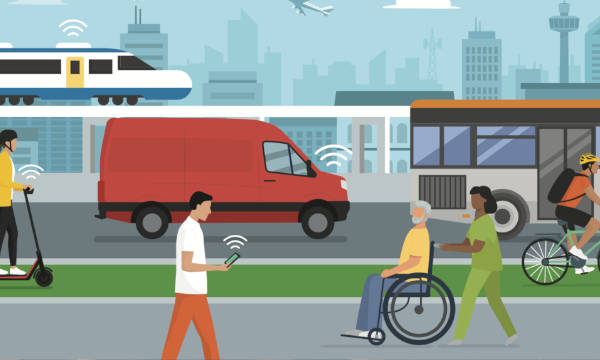
Biden Administration Unveils Roadmap For A Greener, More Equitable Transportation Sector
24 Jan 2023 | Abstracted from Grist
"...the 88-page roadmap envisions a low-emissions mobility system that is "clean, safe, secure, accessible, affordable, and equitable, and provides sustainable transportation options for people and goods."
The document lays out three overarching strategies for decarbonizing transportation...replacing fossil fuels with cleaner alternatives...two other strategies: 'increasing convenience' and 'improving efficiency'..."
ADDITIONAL RELATED NEWS LINKS
.jpg)
.jpg)
.jpg)
.jpg)
.png)




No comments:
Post a Comment